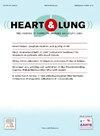Effectiveness and safety of emergency transcatheter aortic valve replacement in patients with severe aortic stenosis complicated by cardiogenic shock: A systematic review and meta-analysis
IF 2.6
4区 医学
Q2 CARDIAC & CARDIOVASCULAR SYSTEMS
引用次数: 0
Abstract
Background
The application of transcatheter aortic valve replacement (TAVR) has been developed on different populations in many clinical studies. However, research dedicated to the application of emergency TAVR in patients with aortic stenosis (AS) experiencing cardiogenic shock is limited.
Objective
To investigate the safety and effectiveness of emergency TAVR in AS patients with circulatory collapse.
Methods
Studies on the application of emergency TAVR in AS patients with cardiogenic shock were screened from PubMed, Web of Science, and Embase databases. Two researchers independently screened the literature-extracted data and conducted a meta-analysis was conducted using STATA 16.0 software.
Results
17 studies comprising 36,886 patients undergoing emergency TAVR and 8,530 patients undergoing emergency SAVR or BAV. Emergency TAVR showed no difference in valve implantation success rate compared to elective TAVR. At 30-day endpoints comparison, emergency TAVR exhibited significantly higher all-cause mortality and readmission rates than elective TAVR (RR=2.73 95 %CI 2.04–3.65, P < 0.01; RR=1.2 95 %CI 0.9–1.6, P < 0.01), but reduced mortality risk compared to emergency SAVR/BAV (RD=-0.15 95 %CI -0.25 to -0.04, P = 0.005). At one year post-operation, people with emergency TAVR continued to have higher all-cause mortality than elective TAVR (RR=1.55 95 %CI 1.37–1.74, P < 0.01) but similar with emergency SAVR/BAV (RD=-0.04 95 %CI -0.33 to 0.25, P = 0.796). Rates of severe bleeding and new-onset renal dialysis were higher after emergency TAVR, compared to elective TAVR, while the incidences of permanent pacemaker implantation, severe paravalvular leakage and stroke were similar.
Conclusion
Despite emergency TAVR having higher readmission and mortality rates compared to elective TAVR, it is a relatively safe and effective treatment in cases of cardiogenic shock compared to emergency BAV/SAVR.
严重主动脉瓣狭窄并发心源性休克患者紧急经导管主动脉瓣置换术的有效性和安全性:系统综述和荟萃分析
背景经导管主动脉瓣置换术(TAVR)已在许多临床研究中应用于不同人群。方法从PubMed、Web of Science和Embase数据库中筛选有关主动脉瓣狭窄(AS)伴心源性休克患者应用急诊TAVR的研究。结果17项研究包括36886名接受急诊TAVR的患者和8530名接受急诊SAVR或BAV的患者。与择期 TAVR 相比,急诊 TAVR 的瓣膜植入成功率没有差异。在30天终点比较中,急诊TAVR的全因死亡率和再入院率明显高于择期TAVR(RR=2.73 95 %CI 2.04-3.65,P< 0.01;RR=1.2 95 %CI 0.9-1.6,P< 0.01),但与急诊SAVR/BAV相比,死亡率风险降低(RD=-0.15 95 %CI -0.25至-0.04,P = 0.005)。术后一年,急诊TAVR患者的全因死亡率仍高于择期TAVR(RR=1.55 95 %CI 1.37-1.74,P = 0.01),但与急诊SAVR/BAV相似(RD=-0.04 95 %CI -0.33至0.25,P = 0.796)。尽管急诊TAVR的再入院率和死亡率高于择期TAVR,但与急诊BAV/SAVR相比,急诊TAVR是一种相对安全有效的心源性休克治疗方法。
本文章由计算机程序翻译,如有差异,请以英文原文为准。
求助全文
约1分钟内获得全文
求助全文
来源期刊

Heart & Lung
医学-呼吸系统
CiteScore
4.60
自引率
3.60%
发文量
184
审稿时长
35 days
期刊介绍:
Heart & Lung: The Journal of Cardiopulmonary and Acute Care, the official publication of The American Association of Heart Failure Nurses, presents original, peer-reviewed articles on techniques, advances, investigations, and observations related to the care of patients with acute and critical illness and patients with chronic cardiac or pulmonary disorders.
The Journal''s acute care articles focus on the care of hospitalized patients, including those in the critical and acute care settings. Because most patients who are hospitalized in acute and critical care settings have chronic conditions, we are also interested in the chronically critically ill, the care of patients with chronic cardiopulmonary disorders, their rehabilitation, and disease prevention. The Journal''s heart failure articles focus on all aspects of the care of patients with this condition. Manuscripts that are relevant to populations across the human lifespan are welcome.
 求助内容:
求助内容: 应助结果提醒方式:
应助结果提醒方式:


